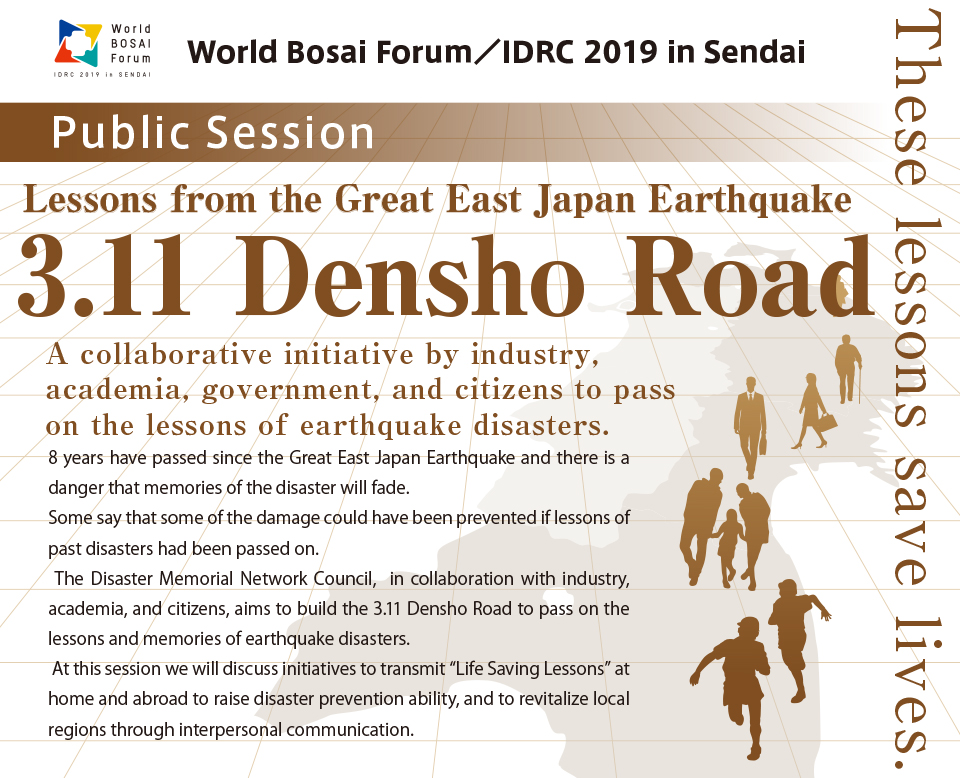Lessons from the Great East Japan Earthquake
3.11 Densho Road
A collaborative initiative by industry, academia, government, and citizens to pass on the lessons of earthquake disasters
The World Bosai Forum & IDRC 2019 took place in Sendai City, Miyagi Prefecture on November 10, 2019. As part of this forum, a public session was held under the auspices of the Disaster Memorial Network Council. At the start of the panel discussion, Mr. SATO Katsuhide, Disaster Memorial Network Council Chairman and Tohoku Regional Bureau Chief, delivered his opening address as follows: Tomorrow will mark eight years and eight months since the Great East Japan Earthquake occurred. There are growing concerns that the records and memories of the disaster may fade with time. The Disaster Memorial Network Council is working on building the 3.11 Densho Road. This is an initiative to pass on the lessons learned from the disaster to the next generation, thereby raising disaster prevention ability and revitalizing local regions. When each one of you utilizes the lessons of the disaster, deeply understands disaster risks, and raises awareness about life-saving action, then society as a whole will be required to turn into a society that is prepared for disasters and conscious about disaster prevention. I hope that you will convey messages both in and outside Japan that encourage people to utilize the lessons of the past and save their lives from disasters.
●Initiatives in Tohoku and the Rest of Japan
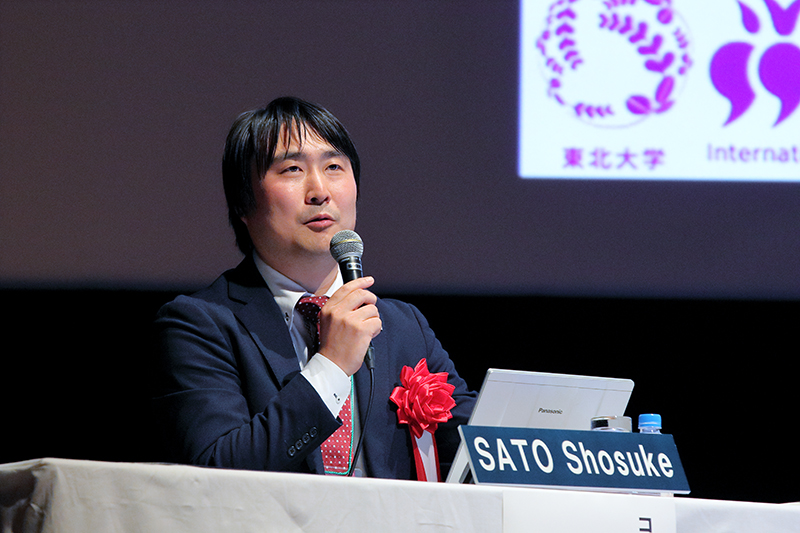
SATO Shosuke, Associate Professor from the International Research Institute of Disaster Science, Tohoku University:
My research theme is how past disasters and experiences can be conveyed. I also research the impact of stories told by storytellers on the bodies and memories of listeners as well as the handing down of past experiences through festivals, and work on the online enhancement of knowledge about disasters.
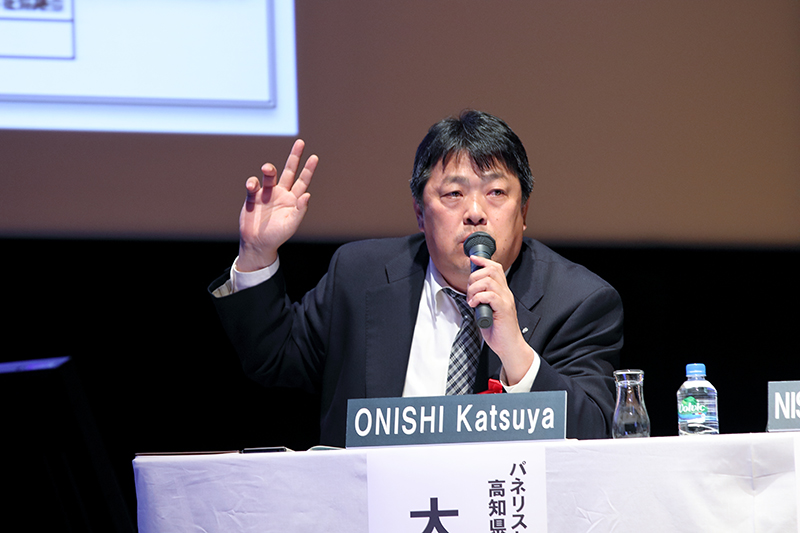
ONISHI Katsuya, Mayor of Kuroshio Town in Kochi Prefecture:
Of today’s panelists, I am the only one who have not experienced a disaster. According to a simulation of a massive earthquake along the Nankai Trough off Shikoku Island, Kuroshio Town will face a magnitude-seven tremor and a 34.4-meter tsunami, and one-meter tsunami will reach the coastal areas of Kochi Prefecture within two minutes at the earliest. These three reports created an uproar among the people.
Since then, we have made various efforts, so let me introduce one of them. That is to fill in the Household Tsunami Evacuation Behavior Sheet in order to check the evacuation environment for each household. We held this workshop about 300 times, and it was the most effective among our efforts. There are 3,791 households in the area with the risk of flooding. The attendance rate from this area is about 65% and the Household Tsunami Evacuation Behavior Sheet creation rate reached 100%. I think that ideally the government should take the initiative in disaster prevention and then the initiative should be transferred to citizens at the right time.
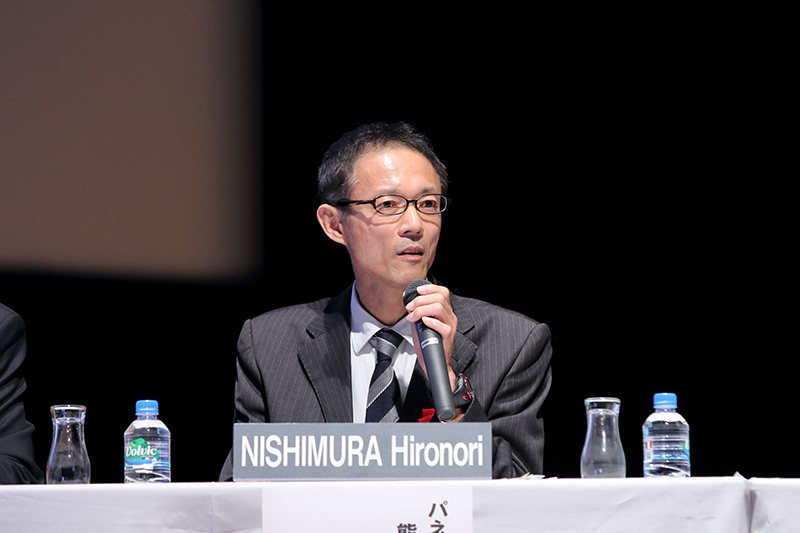
MOCHIDA Hiroshi, Deputy Director-General in Charge of Civil Engineering in Mashiki Town in Kumamoto Prefecture:
Mashiki Town was affected by the Kumamoto Earthquake, being hit by two magnitude-seven earthquakes as a foreshock and an aftershock. After that, about 4,500 aftershocks were registered for two years. A total of 98% of houses in the town was damaged. Of that, about 30% was totally collapsed. This taught us the three important lessons of building a disaster-resistant town, making everyday preparations, and developing human resources and organizations. In addition, I also think that it is important to pass on the lessons of disasters, which is the theme of today’s session.
Mashiki Town had a very weak infrastructure. The Kumamoto Takamori prefectural road is now being constructed. This will run through the center of our town with four lanes, a total length of 3.5 km and a width of 27 m. We plan to use this road to secure a disaster prevention space and revitalize the town. To cooperate between the government and citizens to promote the development of a disaster-resistant town, the Town Development Council was also established.
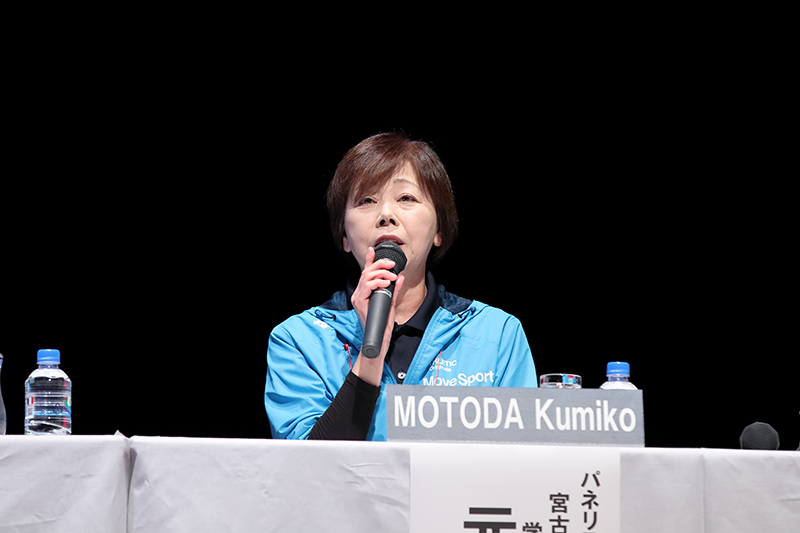
MOTODA Kumiko, Disaster Prevention Tour Guide from the Miyako Tourism Cultural Exchange Association:
I am a tour guide for the Taro district in Miyako City, Iwate Prefecture. I have started to work as a tour guide about one year after the earthquake. When I was asked to do this job, my family members had not returned home yet, so I did not want to do this job. At that time, I recalled my father-in-law, who experienced war as well as tsunami in 1933. He told his stories every night when he got drunk. I did not listen to him seriously. People tend to think they can go through hardships without any guarantees. Now that I experienced tsunami, I want other people to utilize my experience. Now is my turn to tell my stories. With this in mind, I am working as a tour guide.
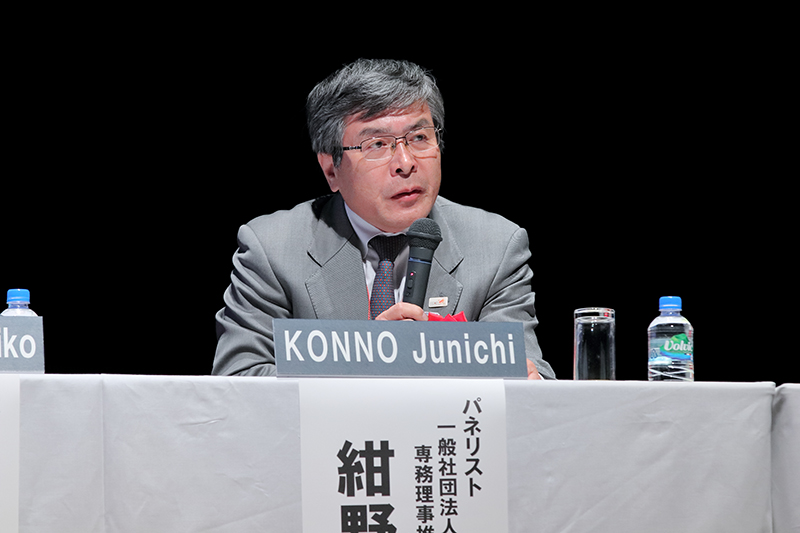
KONNO Junichi, Executive Director General of Promotion from the Tohoku Tourism Promotion Organization:
Tourism has great potential to re-energize people and regions. It is as important to pass on the lessons of the 3.11 earthquake through tourism as it is to learn the importance of peace in Okinawa and Hiroshima. Recently, the number of inbound tourists to Japan has significantly increased. increased, but in Tohoku, the number declined after the earthquake. It recovered to the pre-disaster level in 2015, but the situation is still tough in Tohoku, compared to the rest of the country.
Tohoku has a lot to offer to tourists. A new path has opened in Tohoku in June this year, spanning 1,025 km from Hachinohe City to Soma City. The name of this path is the Michinoku Coastal Trail, which is the project launched by the Ministry of the Environment. The Densho Road is the route that connects the coastal areas in Tohoku. Using these efforts, we hope that we can work on building a system that turns the negative legacy from the earthquake into a positive one.
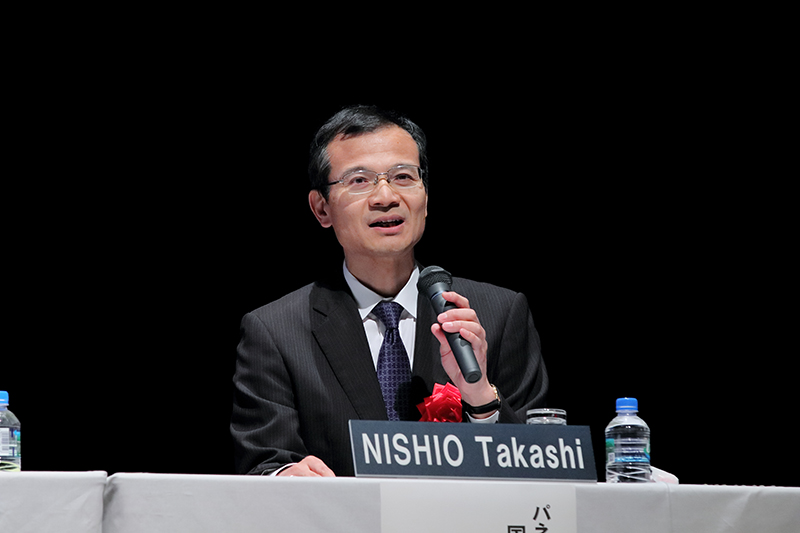
NISHIO Takashi, Head of Planning from the Tohoku Regional Bureau, the Ministry of Land, Infrastructure , Transport and Tourism:
The Great East Japan Earthquake damaged all the roads to coastal areas. Soon after the earthquake, the roads were completely covered by debris. The so-called Comb Tooth Operation was carried out to secure routes for emergency rescue activities by removing debris to clear off the 15 major roads for ambulances and self-defense force fleets. People in the local construction industry engaged in this operation. Since then, eight years and eight months have passed. A plan was devised to develop a 550km reconstruction assistance road in Tohoku and fix the collapsed 9km levee and damaged ports. As of today, the plan has been completed by about 80 to 90%.
●Passing on and Utilizing Lessons to Prepare for Disasters
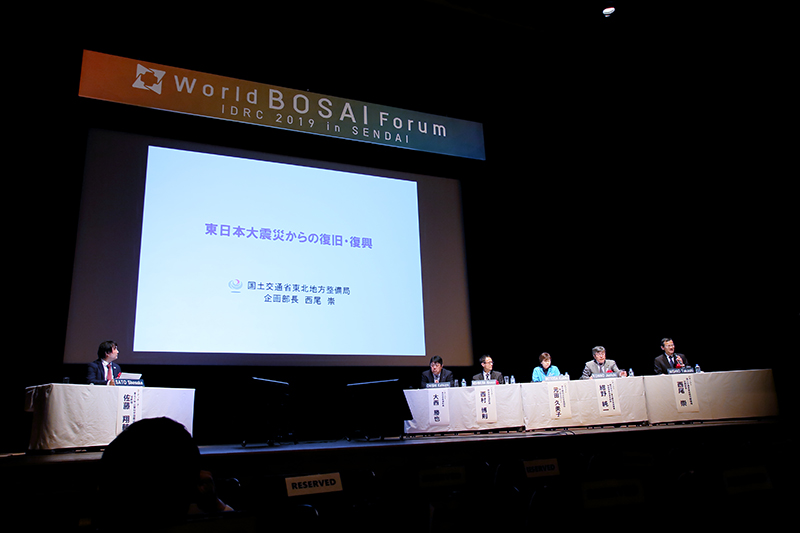
SATO: Today’s theme is “Densho” Can you tell us about the way of utilizing lessons of disasters and the significance of "Densho"?
ONISHI: Simply put, it is to be prepared. To ask myself, have I been prepared for disasters based on the lessons of the Great East Japan Earthquake, or has the town administration taken all possible measures? It is necessary for us to make a commitment that we will learn from the affected areas. So, we began to take action this year. We received advice from Higashi Matsushima City that was devastated by the earthquake, and will revise various plans next year. The point is to have a sense of ownership over the Great East Japan Earthquake and be prepared for disasters. The greatest lesson is to bring this awareness into reality.
MOCHIDA: Mashiki Town learned the three lessons from the Kumamoto Earthquake as I introduced earlier. To utilize them, people need to play important roles, so we are working on developing human resources and organizations. This effort will lead us to revitalize the town for the next 100 years and utilize the lessons learned. This cannot be achieved by the town office alone. We all work together in Mashiki Town.
MOTODA: We need to adopt advice from our forerunners. This was ture“Tsunami comes after a large earthquake. Evacuate to a high place, not to a faraway place.”This was ture“ Tsunami comes after a long tremor regardless of the magnitude. These were true. I want people not just to get information from news but also to visit the site to see, touch and feel it. It is important to utilize the lessons together with you to leave them in tangible forms whenever possible.
KONNO: It is very important to speak real experiences and lessons directly to people. In tours guided by storytellers who have experienced the 3.11 tsunami or who have engaged in rescue work around that time, they directly speak to visitors at the site. I strongly feel that this will lead to disaster prevention and mitigation. Utilizing lessons effectively and going to see the site will take you to the next step.
NISHIO: Natural disasters frequently occur throughout Japan. Some lives could have been protected from these disasters. Flooding killed dozens of people in the Koyaura district of Saka Town, Hiroshima last year. At the site, There is monument to the flooding that hit the area 111 years ago. It is also very important to leave lessons in this form. Tohoku has living lessons. I hope that we can utilize these lessons to disaster control measures not only in Japan but also around the world.
●Challenges for Us to Continuously Pass on Lessons
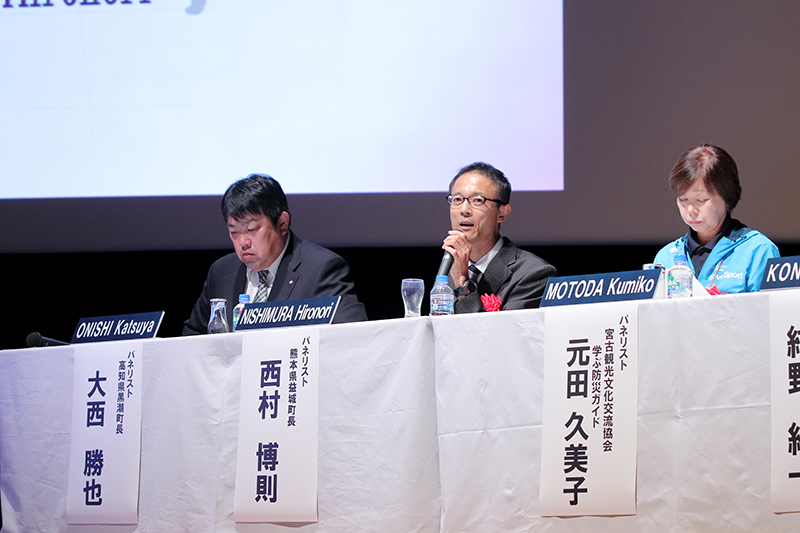
SATO: You may find some challenges when engaging in various activities or looking at Tohoku from your place. Can you tell us about these challenges?
MOTODA: We are often told that storytellers are aging, which makes it difficult to take the next step. This is because storytelling is carried out by volunteers. For young people to make their living, storytelling needs to be established as business, otherwise successors cannot be found. We will bolster our efforts to pass the torch to the younger generation.
MOCHIDA: Three and a half years have passed since the Kumamoto Earthquake. I think that Mashiki Town has moved from the post-disaster recovery phase to a phase of rigorously pushing forward reconstruction and redevelopment. The future challenge for us is to stick to the lessons learned from the earthquake to push forward reconstruction and redevelopment. Towards the goal of the reconstruction and redevelopment project, we need to examine how to pass on the lessons learned and lay the foundation for the future.
ONISHI: The major challenge for us is preventive measures against tsunami. The survival factor is evacuation behavior and voluntary action. However, it is difficult to take voluntary action, and there are limitations in taking action on an individual basis. What can the local and central governments do for that? We need to continue long-term activities in consideration of human characteristics. This must be the biggest challenge under the current situation.
NISHIO: I have started to work here in Tohoku since last year and I have visited areas along the Pacific coast. There are many affected areas, so if you are not in Tohoku, you may be puzzled where to learn about the disaster. Individual influence is not so strong. After all, the major challenge is how to strengthen the influence of Tohoku as a whole. We also need to formulate an arrangement to integrate the lessons scattered in the affected areas.
KONNO: I think that the major challenge is how to deal with disaster prevention and mitigation as the population is aging and declining in Japan. Tohoku has six prefectures with a population of about 8.3 million. The affected areas are faced with a decrease in population. We need to think about utilizing the region’s industry of tourism, thereby revitalizing people-to-people exchanges and increasing the population. For disaster prevention and mitigation, and tourism, it is also very important to promote cooperation between the government and citizens.
●Objective of the 3.11 Densho Road
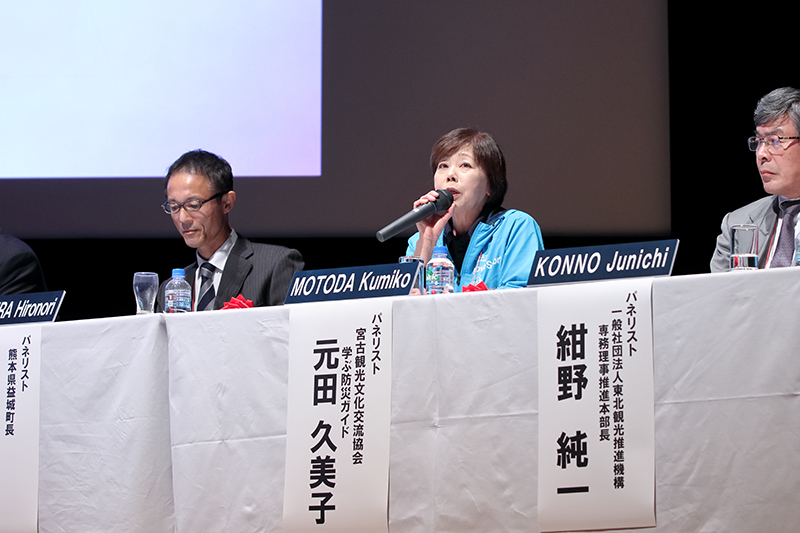
SATO: Thank you. The panelists have raised various challenges. I've been hearing told that the Disaster Memorial Network Council is involved in activities to solve these challenges. Can you introduce us to the activities?
NISHIO: There are many lessons in the affected areas. If we have networks to connect lessons and facilities that are scattered in the affected areas, we can pass on the lessons efficiently and effectively. To this end, the Disaster Memorial Network Council was established. First, a system was built to register areas, where lessons were gained, as facilities to pass on the lessons of the disaster. As of today, about 200 areas were registered. To guide these facilities, standardized pictograms were designed. The second activity is to use these facilities to create disaster prevention programs and education programs. The third activity is to coordinate with tourism, international conferences, and other events. The Council is discussing these three activities. I would appreciate it if you could give us your opinions and suggestions about these activities.
KONNO: We are putting great efforts into education trips to Tohoku in order to pass on the 3.11 disaster to students through school trips. This year, we started to invite people who involved in education trips from Taiwan and China to the affected areas. We made an arrangement to allow them to listen to stories from storytellers and visit the facilities registered to pass on the lessons of the disaster.
MOTODA: Our challenge is to increase the number of students visiting the affected areas through school trips. So far, we have guided 175,000 people. Of them, 30% were students. After they start their career, they may live in new places. They should be prepared for disasters. That’s why this kind of education is necessary. I hope that students learn anything meaningful as much as they can from this Densho Road.
ONISHI: Should storytellers take the initiative? I think that we, who are taught lessons by them, should play key roles. We should frequently visit Tohoku, keep up our interest in the region, sympathize with people there, and maintain an attitude of learning lessons earnestly. We, as the top management of the government, must continue to have this awareness.
MOCHIDA: I think that it is important to continue developing human resources, organizations and the town. That’s why I am working to pass on the memories of the disaster. Creating and maintaining a new arrangement of passing on lessons will help each person to be permanently prepared for disasters.
SATO: Let me summarize today’s session. Today, we have discussed under the key theme of “Densho”. I understand that the common message from the panelists is to avoid a society where lives are lost because of “not knowing.” The first meaning of the Densho Road is to connect the past to the present. The second meaning is to connect communities. The third meaning is to connect between industry, government, academia, and citizens. In conclusion, we hope that you use the 3.11 Densho Road and cheer on people, thereby creating a society being conscious about disaster prevention.
